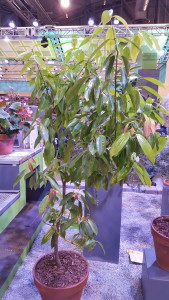
Cinnamon tree on display at a flower show
Cinnamon is a spice that is harvested from the bark of cinnamon trees. The cinnamon you find in the grocery store is actually Cinnamomum cassia, also known as Chinese Cinnamon or Cassia. It is easy to distinguish it from true cinnamon (C. verum). Chinese cinnamon is coarser, the sticks are thicker and it is harder to grind. The flavor is stronger than the delicate flavor of true cinnamon. True cinnamon sticks are much thinner and crush more easily. True cinnamon is considered a premium cinnamon.
Cinnamon has been used for millennia, in both food and incense, as well as in traditional Chinese medicine. The Egyptians imported it. It is mentioned many times in the Bible. Both the Greeks and the Romans used it. All mistakenly believed that cinnamon came from China. Not true! Only Chinese cinnamon is native to China. True cinnamon is native to Sri Lanka. Other species are native to areas of Southeast Asia.
True cinnamon is a slow growing tree that is suitable for container growing. It is hardy in zones 10 through 12 so you will need to bring your cinnamon indoors during the winter or any time that outdoor temperatures fall below 40⁰F. Indoors, the temperature should not fall below 60⁰F.
Cinnamon prefers full sun, but will tolerate some shade making it suitable to grow indoors during the winter. It needs well-drained soil and should not be over-watered which could result in root rot. It is best to allow the top 2 inches of soil to dry out between waterings.
During the growing season, you can fertilize your plant with a 8-3-9 fertilizer. Do not fertilize during the winter months.
You should keep your tree pruned to a height between 3- to 8-feet. The trees will flower (white) during the spring and early summer, followed by small purple fruit which is inedible. Each berry contains a single seed which can be harvested for planting. The berries are ripe when they turn black. The seeds should be planted immediately because they are not viable for very long. You can also propagate cinnamon by cuttings but it is difficult to get the cuttings to root.
Harvesting your cinnamon is not difficult. You can harvest from either the trunk (mature) or what are known as “whips” (young). Whips are simply young stems. Some people constantly prune their trees to encourage the growth of whips which are considered more fragrant than the older bark on the main trunk.
To harvest from the main trunk, first cut 3 inch segments into the bark, then cut lengthwise into the bark but don’t go all the way through. With some difficulty it will peel away from the stem. Scrape out the inner lining and allow the bark to dry. It will naturally curl up like the cinnamon sticks that you see sold in the stores.
Whips are easier to harvest. Prune the whips off of your tree and cut them into 3 inch segments. Then cut into the bark and peel it from the stem. It should come away easier than mature bark. Allow the bark to dry and curl up into “cinnamon sticks”.

